
The Internet's Premier Classical Music Source
Related Links
-
Ippolitov-Ivanov Reviews
Kodály Reviews - Latest Reviews
- More Reviews
-
By Composer
-
Collections
DVD & Blu-ray
Books
Concert Reviews
Articles/Interviews
Software
Audio
Search Amazon
Recommended Links
Site News
 CD Review
CD Review
Kodály / Ippolitov-Ivanov

Dances & Sketches
- Zoltán Kodály:
- Dances of Galánta
- Dances of Marosszék
- Suite "Háry János"
- Mikhail Ippolitov-Ivanov: Caucasian Sketches: Suite #1
Royal Philharmonic Orchestra/Artur Rodzinski
Westminster 471267-2 ADD monaural 74:54
Zoltán Kodály's Dances of Gálanta (1933) offer nearly foolproof excitement. The composer's medley of actual tunes (some of them recruiting dances, actually) from a western Hungarian village becomes increasingly frenetic, and at the end of the 16-minute showpiece, the orchestra seems to throw itself to the ground in exhilarated exhaustion. Who needs stimulants? The Dances of Marosszék, written four years earlier, come from the Transylvanian region on the other side of the country. Here, the tunes are less Westernized, and there is a feeling of "ancient music" absent from the later collection. While Dances of Gálanta is a surefire crowd-pleaser, Dances of Marosszék offers subtler and less breathless pleasures. Rodzinski conducts both of them superbly, with complete sympathy for their melancholy and eruptive Magyar ethos. His refusal to keep phrase after phrase at the same boring dynamic level immeasurably enlivens the music.
The "Intermezzo" from Háry János leaves no doubt that Rodzinski must have had first-hand experience with Hungarian gypsy music. The Royal Philharmonic Orchestra's violins are allowed to swoop and wail like any charismatic primás. It's all the poor (and uncredited) cimbalom-player can do to keep up. "The Battle and Defeat of Napoleon" is less vivid than on other recordings, but it is clear that Rodzinski is content to take it more at face value, and not to play it for laughs. All in all, Rodzinski keeps Háry in good hands.
The Caucasian Sketches were recorded at about the same time (April 1955) but were issued on a different LP than the Kodály selections. There's more to this music than the appealingly vulgar "Procession of the Sardar" – it's an unfaded picture postcard of simple, real people, and the country they called their own. Ippolitov-Ivanov, like Kodály a generation later, recognized the worth in uncollected folktunes. They are seamlessly integrated into this First Suite. (The Second Suite isn't bad either.) Rodzinski is only marginally less enjoyable here than he was in the Kodály.
The monaural sound was top-drawer in the mid-1950s, and it still sounds good. The frequency range and depth of the engineering remain impressive almost fifty years later.
The volatile, difficult Rodzinski was not always at his best during this period – his health was poor – but there's nothing weak about the conducting on this CD. Hungarians will hear proof that a conductor born in Dalmatia can have Magyar blood flowing in his veins anyway.
Copyright © 2002, Raymond Tuttle


















